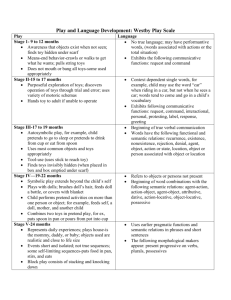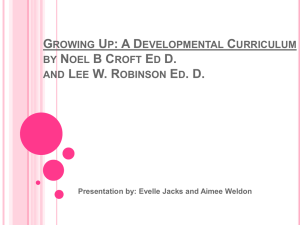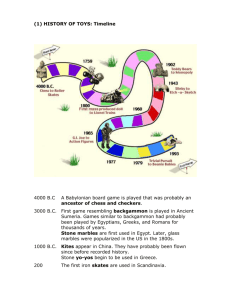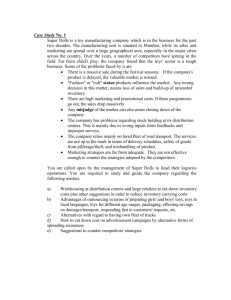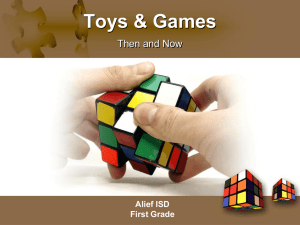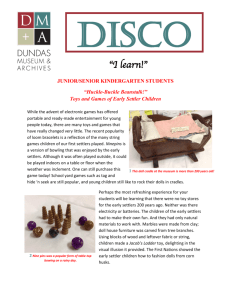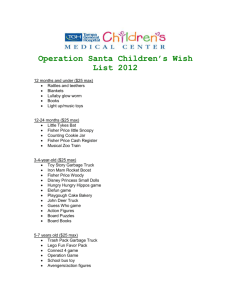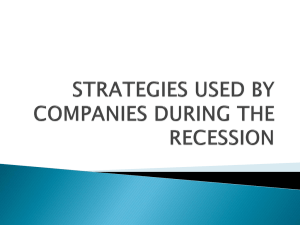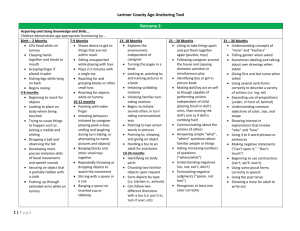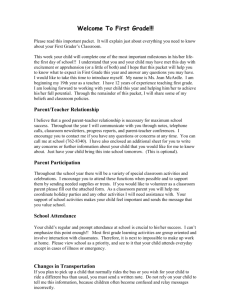Westby Play Scale: Language & Play Development
advertisement
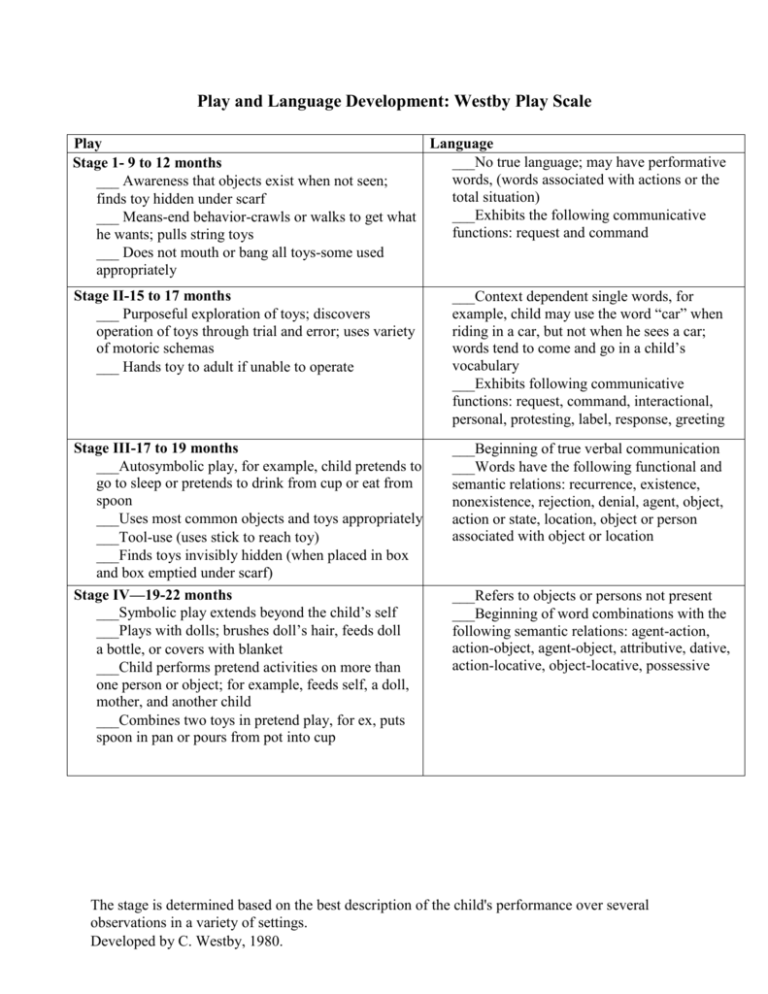
Play and Language Development: Westby Play Scale Play Language ___No true language; may have performative Stage 1- 9 to 12 months words, (words associated with actions or the ___ Awareness that objects exist when not seen; total situation) finds toy hidden under scarf ___Exhibits the following communicative ___ Means-end behavior-crawls or walks to get what functions: request and command he wants; pulls string toys ___ Does not mouth or bang all toys-some used appropriately Stage II-15 to 17 months ___ Purposeful exploration of toys; discovers operation of toys through trial and error; uses variety of motoric schemas ___ Hands toy to adult if unable to operate ___Context dependent single words, for example, child may use the word “car” when riding in a car, but not when he sees a car; words tend to come and go in a child’s vocabulary ___Exhibits following communicative functions: request, command, interactional, personal, protesting, label, response, greeting Stage III-17 to 19 months ___Autosymbolic play, for example, child pretends to go to sleep or pretends to drink from cup or eat from spoon ___Uses most common objects and toys appropriately ___Tool-use (uses stick to reach toy) ___Finds toys invisibly hidden (when placed in box and box emptied under scarf) Stage IV—19-22 months ___Symbolic play extends beyond the child’s self ___Plays with dolls; brushes doll’s hair, feeds doll a bottle, or covers with blanket ___Child performs pretend activities on more than one person or object; for example, feeds self, a doll, mother, and another child ___Combines two toys in pretend play, for ex, puts spoon in pan or pours from pot into cup ___Beginning of true verbal communication ___Words have the following functional and semantic relations: recurrence, existence, nonexistence, rejection, denial, agent, object, action or state, location, object or person associated with object or location ___Refers to objects or persons not present ___Beginning of word combinations with the following semantic relations: agent-action, action-object, agent-object, attributive, dative, action-locative, object-locative, possessive The stage is determined based on the best description of the child's performance over several observations in a variety of settings. Developed by C. Westby, 1980. Stage V-24 months ___Represents daily experiences; plays house-is the mommy, daddy, or baby; objects used are realistic and close to life size ___Events short and isolated; not true sequences; some self-limiting sequences-puts food in pan, stirs, and eats ___Block play consists of stacking and knocking down ___Sand andyears water play consist of filling, pouring, Stage VI- 21/2 and dumping ___Represents events less frequently experienced or observed, particularly impressive or traumatic events: doctor/nurse/sick child or teacher/child ___Events still short and isolated. Realistic props still required. Roles shift quickly. Stages VII-3 years ___Continues pretend activities of Stages V and VI, but now the play has sequence. Events are not isolated, for example, child mixes cake, bakes it, serves it, washes dishes ___Sequence evolves, not planned ___Compensatory toy..re-enactment of experienced events with new outcomes ___Associative play (the child’s play is loosely organized around a common activity, shared interest, and materials) Stage VIII-3 to 31/2 years ___Carries out play activities of previous stages with a doll house and Fisher Price toys (barn, garage, airport, village) ___Uses blocks and sandbox for imaginative play. Blocks used primarily as enclosures for animals and dolls ___Play not totally stimulus bound. Child uses one subject to represent another ___Uses earlier pragmatic functions and semantic relations in phrases and short sentences ___The following morphological makers appear: present progressive on verbs, plurals, possessives ___Responds appropriately to WH questions in context: ___Asks wh questions, generally puts “wh” at beginning of sentence ___Responses to why questions inappropriate expect for well-know routines, such as, “Why is the doctor here?.”baby sick” ___Asks why, but often inappropriate and does not attend to answer ___Uses past tense, such as “I ate the cake..I walked” ___Uses future aspect (particularly “gonna”) forms, such as “I’m gonna wash dishes.” ___Descriptive vocabulary expands as child becomes more aware of perceptual attributes. Uses terms for the following concepts (not always correctly: shapes, sizes, colors, texture, spatial relationships, gives dialogue to puppets and dolls, metalinguistic language use, uses indirect requests (Mommy lets me have cookies for breakfast), changes speech depending on listener The stage is determined based on the best description of the child's performance over several observations in a variety of settings. Developed by C. Westby, 1980. Stage IX-3/12 to 4 years ___Begins to problem-solve events not experienced. Plans ahead. Hypothesizes ___Uses dolls and puppets to act out scenes ___Builds 3-dimensional structures with blocks which are attempts at reproducing specific structures child has seen ___Verbalizes intentions and possible future events: ___Uses modals (can, may, might, will, would, could) ___Uses conjunctions (and, but, if, so, because) (full competence for modals doesn’t develop until 10-12 years of age) ___Begins to respond appropriately to why and how questions that require reasoning about perception Stage X-5 years ___Plans sequence of pretend events ___Organizes what he needs-both objects and other children ___Coordinates more than one event occurring at a time ___Highly imaginative. Sets the scene without realistic props. ___Full cooperative play (Child’s play included different roles, common goals, usually with 1 or 2 leaders, and is of relatively long duration and complexity) ___Next, last, while, before, after (full competence doesn’t develop until 10-12 years of age) The stage is determined based on the best description of the child's performance over several observations in a variety of settings. Developed by C. Westby, 1980.
